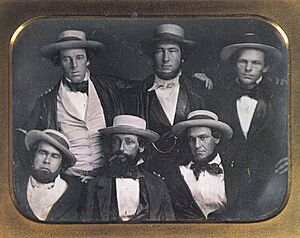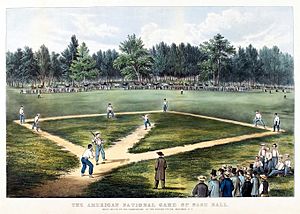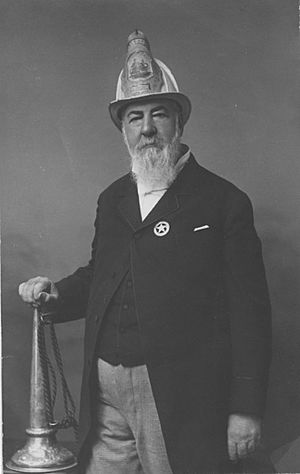Alexander Cartwright facts for kids
Quick facts for kids Alexander Cartwright |
|
|---|---|
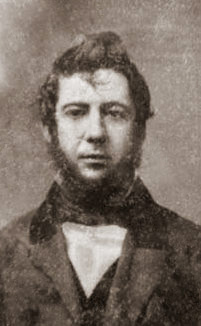
Cartwright in 1855
|
|
| Born: Alexander Joy Cartwright Jr. April 17, 1820 New York City, US |
|
| Died: July 12, 1892 (aged 72) Honolulu, O'ahu, Kingdom of Hawai'i |
|
| Career highlights and awards | |
|
|
| Induction | 1938 |
| Election Method | Centennial Committee |
Alexander Joy Cartwright Jr. (born April 17, 1820 – died July 12, 1892) was an important person in the early history of baseball. He was a founding member of the New York Knickerbockers Base Ball Club in the 1840s. Many people consider him one of the "fathers of baseball."
Cartwright was put into the Baseball Hall of Fame in 1938. This happened 46 years after he passed away. For a long time, people thought the rules of modern baseball came from the "Knickerbocker Rules." These rules were created in 1845 by Cartwright and others from the Knickerbockers club. However, later studies have shown that some of these rules might have been used before.
Contents
Early Life & First Jobs
Alexander Cartwright Jr. was born in 1820 in New York City. His father, Alexander Cartwright Sr., was a sea captain. Alexander Jr. had six brothers and sisters.
When he was 16, in 1836, he started working as a clerk on Wall Street. Later, he worked at the Union Bank of New York. After work, he loved to play bat-and-ball games in the streets of Manhattan. He played with volunteer firefighters, and he was a volunteer firefighter himself.
In 1845, a big fire destroyed the Union Bank. This made Cartwright find new work. He became a bookseller with his brother, Alfred.
Founding the Knickerbockers
Before the Knickerbockers, there was a club called the Gotham Base Ball Club. They played a game similar to baseball, sometimes called "town ball." In 1842, Cartwright helped start the Knickerbocker Base Ball Club. This new club was a group that broke away from the Gothams.
In 1845, a group from the Knickerbockers wrote down some rules. These rules were similar to the Gothams' rules. Key new rules included having foul areas for the first time. Also, players could no longer be put out by being hit with a thrown ball.
Some people mistakenly thought Cartwright created rules like flat bases, three strikes for a batter, and nine players in the outfield. However, experts now believe these rules were already in use or were set later by other groups. For example, the rules about nine players and 90-foot base paths were set in 1857, after Cartwright had left New York.
The first official game between two baseball clubs using these rules happened on June 19, 1846. The Knickerbockers played against the "New York nine" (likely the Gotham Club) in Hoboken, New Jersey. The Knickerbockers lost the game 23 to 1.
Life in Hawaii
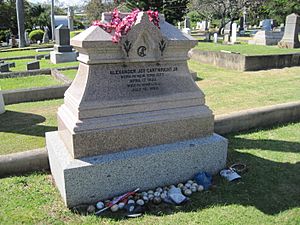
In 1849, Cartwright traveled to California for the gold rush. But he soon moved to the Kingdom of Hawaii to live and work. His family joined him in 1851. He had five children in total. Two of his sons, Bruce and Alexander Joy III, were born in Hawaii.
Some stories say Cartwright set up a baseball field in Hawaii in 1852. However, it seems that modern baseball was not played in Honolulu until after 1866. Also, during his lifetime, Cartwright was not known as the person who brought baseball to Hawaii.
Cartwright became the fire chief of Honolulu in 1850 and served until 1863. He also advised King David Kalākaua and Queen Emma. Cartwright passed away on July 12, 1892. He was buried in Oahu Cemetery.
His Baseball Legacy
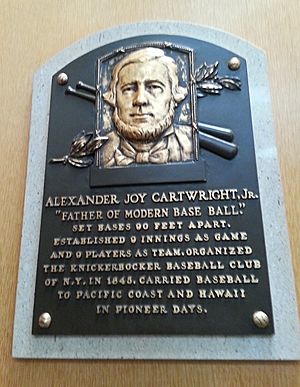
For many years, there was a debate about who invented baseball. Some believed it was Abner Doubleday. However, this idea was later proven to be a myth.
Alexander Cartwright was put into the Baseball Hall of Fame in 1938. His plaque there calls him the "Father of the Modern Game of Baseball."
A librarian named Robert W. Henderson wrote a book in 1947 about Cartwright's role in baseball. While Cartwright was very important in baseball's early days, some historians think his role might have been made to seem bigger than it was. This was partly to find a single person to credit for inventing baseball, instead of Doubleday.
In 2004, a newspaper interview from a fellow Knickerbocker founder, William R. Wheaton, was found. Wheaton said that many of the rules often credited to Cartwright and the Knickerbockers were actually developed by the older Gotham Club before the Knickerbockers even started.
Today, Makiki Field in Honolulu is called Cartwright Field. The Cartwright Cup is also given to the Hawaii state high school baseball champions every year.
Rules of Baseball in 1857
In 2016, experts confirmed some old documents called "Laws of BaseBall." These were written in 1857 by Daniel "Doc" Adams, who was the president of the New York Knickerbockers. He wrote them after talking with other baseball clubs.
These documents set important rules for the game. For the first time, they officially stated:
- Nine innings in a game.
- Nine players on the field.
- 90-foot distances between bases.
Cartwright was not at this meeting because he was already living in Hawaii. This shows that the rules of baseball continued to change and grow even after he left New York.
Biography Timeline
- April 17, 1820: Born in New York City.
- 1836: Started working as a bank clerk and played "town ball."
- 1842: Married Eliza Van Wie; they had five children.
- 1845: Co-founded the Knickerbocker Base Ball Club. He helped write the first set of baseball rules, known as the Knickerbocker Rules.
- June 19, 1846: The Knickerbocker Base Ball Club played its first official game using these rules.
- 1849: Left New York and moved to Hawaii.
- 1850: Became Honolulu's first fire chief.
- 1851: Helped start the Honolulu Library and Reading Room.
- July 12, 1892: Died in Honolulu, Hawaii.
- 1938: Inducted into the Baseball Hall of Fame as a pioneer of the game.
- 1953: The U.S. Congress officially recognized him as the inventor of modern baseball.
See Also
 In Spanish: Alexander Cartwright para niños
In Spanish: Alexander Cartwright para niños



